Initial Teacher Education for Inclusive Education: A Bibliometric Analysis of Educational Research
Abstract
:1. Introduction
2. Literature Analysis
3. Methods
3.1. Search Strategy
3.2. Data Analysis
4. Results
4.1. RQ1: What IS the Volume and Distribution (Countries, Organizations, and type of Papers) of Scientific Research in ITEIE?
4.1.1. The Volume of ITEIE Research
- An early stage, from 1996 to 2007, when 26 documents were published, representing 8.78% of the total number;
- a moderate growth stage from 2008 to 2014, when 120 papers were published, which accounts for 27.27% of the total amount. The number of publications increased by over four times compared to the previous period;
- a high growth stage from 2015 to 2020, when 294 scientific papers were published. These represent 66.81% of the total amount. The number of publications has increased by two and a half times compared to the previous period. Most publications were registered in 2019 (n = 74). The lower number of publications in 2020 is explained by the fact that only the works indexed on WoS until the date of the search presented in this study were considered (7 April 2020).
4.1.2. Distribution across Countries
4.1.3. Distribution across Organizations
4.1.4. Distribution by Document Types
- By nature of studies (source of knowledge): Theoretical studies and empirical studies;
- by type of research design and methods of inquiry: Qualitative, quantitative, mixed methods design, case-study, action research, field survey, experimental, descriptive, exploratory, correlational, longitudinal, comparative studies, etc.;
- by the content analyzed: Initial training program’s structure and IE curricula—theoretical instruction on IE and/or field opportunities (direct interaction and/or teaching experiences with students with various disabilities); different variables related to pre-service teachers (beliefs, experiences, attitudes, knowledge, preparation, motivation, concerns, efficacy, teaching skills, or combinations of these topics) in connection with inclusion/IE or the impact of teacher training on these aspects; the use of technology in IE, teacher educators’ attitudes/reflections/challenges related to IE; the validation of research tools in the field of IE, partnerships in IE, etc.;
- by the participants involved: Studies that involve regular school pre-service teachers at different levels of their training (the size of the sample between 1 and 2014 participants), studies that involved besides regular school pre-service teachers, special education pre-service teachers/school mentors/teacher educators/students/teaching assistants; studies that involved only teacher educators;
- by the type of experience: Formal and informal experience;
- by the targeted group: Studies focused on specific categories (individuals with hearing impairments, visual impairments, intellectual disabilities, learning disabilities, autism, Down Syndrome, ADHD, physical or motor disabilities, dyslexia; immigrants, ethnic/religious/sexual minorities, etc.) or studies focused on inclusion in general;
- by the level of education for which the pre-service were trained to teach: Early education, primary education, secondary education;
- by specific domains/disciplines involved: Educational Sciences, Physical Education, Mathematics, English, Science, Music, Art, Theater, etc.;
- by the dimension of the investigation: Local, national, or international studies/projects.
4.2. RQ2: What Are the Most Influential Journals, Authors, and Papers in ITEIE?
4.3. RQ3: What Are the Collaboration Patterns in ITEIE and the Connections Existing between Authors, Journals, and Terms?
4.3.1. Co-Authorship: Authors and Countries
4.3.2. Co-Citation Analysis—Cited Authors, and Cited Sources
4.3.3. Co-Occurrence of Keywords and Terms Analysis
5. Discussion
6. Conclusions
6.1. Limitations and Future Work
6.2. Theoretical and Practical Implications
Author Contributions
Funding
Conflicts of Interest
References
- Walton, E.; Rusznyak, L. Choices in the Design of Inclusive Education Courses for Pre-service Teachers: The Case of a South African University. Int. J. Disabil. Dev. Educ. 2016, 64, 231–248. [Google Scholar] [CrossRef]
- United Nations Educational, Scientific and Cultural Organization. The Salamanca Statement and Framework for Action on Special Needs Education; UNESCO Publishing: Paris, France, 1994; Available online: https://unesdoc.unesco.org/ark:/48223/pf0000098427 (accessed on 20 April 2020).
- United Nations Educational, Scientific and Cultural Organization. United Nations Convention on the Rights of Persons with Disabilities; United Nations Publishing: New York, NY, USA, 2006; Available online: https://www.un.org/disabilities/documents/convention/convention_accessible_pdf.pdf (accessed on 20 April 2020).
- United Nations Educational, Scientific and Cultural Organization. Inclusive Education: The Way of the Future. Conclusions and Recommendations of the 48 the Session of the International Conference on Education; United Nations Publishing: Geneva, Switzerland, 2008; Available online: https://unesdoc.unesco.org/ark:/48223/pf0000180629 (accessed on 20 April 2020).
- United Nations. Transforming Our World : The 2030 Agenda for Sustainable Development: A/RES/70/1; UN: New York, NY, USA, 2015; Available online: https://sustainabledevelopment.un.org/content/documents/21252030%20Agenda%20for%20Sustainable%20Development%20web.pdf (accessed on 20 April 2020).
- United Nations Educational, Scientific and Cultural Organization. Education 2030 Incheon Declaration and Framework for Action; United Nations Publishing: Incheon, Korea, 2015; Available online: https://unesdoc.unesco.org/ark:/48223/pf0000245656 (accessed on 20 April 2020).
- Ainscow, M.; Slee, R.; Best, M. Editorial: The Salamanca Statement: 25 years on. Int. J. Incl. Educ. 2019, 23, 671–676. [Google Scholar] [CrossRef]
- Amor, A.M.; Hagiwara, M.; Shogren, K.A.; Thompson, J.R.; Verdugo, M.A.; Burke, K.M.; Aguayo, V. International perspectives and trends in research on inclusive education: A systematic review. Int. J. Incl. Educ. 2018, 23, 1277–1295. [Google Scholar] [CrossRef]
- Sharma, U.; Forlin, C.; Loreman, T. Impact of training on pre-service teachers’ attitudes and concerns about inclusive education and sentiments about persons with disabilities. Disabil. Soc. 2008, 23, 773–785. [Google Scholar] [CrossRef]
- United Nations Educational, Scientific and Cultural Organization. A Guide for Ensuring Inclusion and Equity in Education; UNESCO: Paris, France, 2017; Available online: https://unesdoc.unesco.org/ark:/48223/pf0000248254 (accessed on 20 April 2020).
- Göransson, K.; Nilholm, C. Conceptual diversities and empirical shortcomings—A critical analysis of research on inclusive education. Eur. J. Spéc. Needs Educ. 2014, 29, 265–280. [Google Scholar] [CrossRef]
- Nilholm, C.; Göransson, K. What is meant by inclusion? An analysis of European and North American journal articles with high impact. Eur. J. Spéc. Needs Educ. 2017, 32, 437–451. [Google Scholar] [CrossRef]
- Krischler, M.; Powell, J.J.W.; Cate, I.M.P.-T. What is meant by inclusion? On the effects of different definitions on attitudes toward inclusive education. Eur. J. Spéc. Needs Educ. 2019, 34, 632–648. [Google Scholar] [CrossRef] [Green Version]
- Magnússon, G. An amalgam of ideals—images of inclusion in the Salamanca Statement. Int. J. Incl. Educ. 2019, 23, 677–690. [Google Scholar] [CrossRef]
- Forlin, C.; Chambers, D. Teacher preparation for inclusive education: Increasing knowledge but raising concerns. Asia Pac. J. Teach. Educ. 2011, 39, 17–32. [Google Scholar] [CrossRef]
- Coates, J.K.; Harris, J.; Waring, M. The effectiveness of a special school experience for improving preservice teachers’ efficacy to teach children with special educational needs and disabilities. Br. Educ. Res. J. 2020. [Google Scholar] [CrossRef]
- Walton, E.; Rusznyak, L. Cumulative knowledge-building for inclusive education in initial teacher education. Eur. J. Teach. Educ. 2019, 43, 18–37. [Google Scholar] [CrossRef]
- Florian, L. Preparing teachers to work in ‘schools for all’. Teach. Teach. Educ. 2009, 25, 533–534. [Google Scholar] [CrossRef]
- Florian, L.; Camedda, D. Enhancing teacher education for inclusion. Eur. J. Teach. Educ. 2019, 43, 4–8. [Google Scholar] [CrossRef]
- Florian, L.; Rouse, M. The inclusive practice project in Scotland: Teacher education for inclusive education. Teach. Teach. Educ. 2009, 25, 594–601. [Google Scholar] [CrossRef]
- Merigó, J.M.; Yang, J.B. Accounting Research: A Bibliometric Analysis. Aust. Account. Rev. 2016, 27, 71–100. [Google Scholar] [CrossRef]
- Grosseck, G.; Țîru, L.G.; Bran, R.A. Education for Sustainable Development: Evolution and Perspectives: A Bibliometric Review of Research, 1992–2018. Sustainability 2019, 11, 6136. [Google Scholar] [CrossRef] [Green Version]
- Zupic, I.; Čater, T. Bibliometric Methods in Management and Organization. Organ. Res. Methods 2014, 18, 429–472. [Google Scholar] [CrossRef]
- Yılmaz, R.M.; Topu, F.B.; Tulgar, A.T. An examination of the studies on foreign language teaching in pre-school education: A bibliometric mapping analysis. Comput. Assist. Lang. Learn. 2019, 1–24. [Google Scholar] [CrossRef]
- Hulme, M.; Wood, J.; Shi, X. Measuring up? Metrics and research assessment in UK teacher education. J. Educ. Teach. 2020, 46, 220–239. [Google Scholar] [CrossRef]
- Cretu, D.M. An analysis of teacher education research in the Web of Science. J. Plus Educ. 2019, 24, 31–38. [Google Scholar]
- Çiftçi, Ş.K.; Danışman, Ş.; Yalçın, M.; Tosuntas, S.B.; Ay, Y.; Sölpük, N.; Karadağ, E. Map of Scientific Publication in the field of Educational Sciences and Teacher Education in Turkey: A Bibliometric Study. Educ. Sci. Theory Pract. 2016, 16, 1097–1123. [Google Scholar] [CrossRef]
- Song, Y.; Chen, X.L.; Hao, T.Y.; Liu, Z.N.; Lan, Z.X. Exploring two decades of research on classroom dialogue by using bibliometric analysis. Comput. Educ. 2019, 137, 12–31. [Google Scholar] [CrossRef]
- Rodríguez-García, A.M.; Torres, J.M.T.; Rodríguez, J.S. Impacto de la productividad científica sobre competencia digital de los futuros docentes: Aproximación bibliométrica en Scopus y Web of Science. Rev. Complut. Educ. 2019, 30, 623–646. [Google Scholar] [CrossRef] [Green Version]
- Viseu, J.N.; De Jesus, S.N.; Quevedo-Blasco, R.; Rus, C.L.; Canavarro, J.M. Motivação docente: Estudo bibliométrico da relação com variáveis individuais, organizacionais e atitudes laborais. Rev. Latinoam. de Psicol. 2015, 47, 58–65. [Google Scholar] [CrossRef] [Green Version]
- Hernández-Torrano, D.; Somerton, M.I.; Helmer, J. Mapping research on inclusive education since Salamanca Statement: A bibliometric review of the literature over 25 years. Int. J. Incl. Educ. 2020, 1–20. [Google Scholar] [CrossRef]
- Shah, S.R.U.; Mahmood, K.; Hameed, A.D. Review of Google scholar, Web of Science, and Scopus search results: The case of inclusive education research. Libr. Philos. Pract. 2017. Available online: https://digitalcommons.unl.edu/cgi/viewcontent.cgi?article=4419&context=libphilprac (accessed on 20 April 2020).
- Lantaron, B.S.; Medialdea, A.L. Research on inclusive education: Production of works in Spanish journals and doctoral thesis. Rev. Educ. Inclusiva 2018, 11, 151–174. [Google Scholar]
- Castro, A.M.P.; Garcia, M.J.M.; Perez, E.M.G. Bibliometric study of scientific production doctoral thesis in Inclusive Education. In Proceedings of the 9th International Conference on Education and New Learning Technologies (EDULEARN), Barcelona, Spain, 3–5 July 2017; pp. 10291–10296. [Google Scholar]
- Esteve, M.I.V.; Suelves, D.M.; Chacón, J.P.; Baldoví, M.I.P. Technologies for attention to diversity: A bibliometric study. In Proceedings of the 5th International Conference on Higher Education Advances (HEAd’19), Valencia, Spain, 26–28 June 2019; pp. 973–981. [Google Scholar] [CrossRef]
- Marín-Marín, J.-A.; Belmonte, J.L.; Fernández-Campoy, J.-M.; Romero-Rodríguez, J.-M. Big Data in Education. A Bibliometric Review. Soc. Sci. 2019, 8, 223. [Google Scholar] [CrossRef] [Green Version]
- Tristani, L.; Bassett-Gunter, R. Making the grade: Teacher training for inclusive education: A systematic review. J. Res. Spéc. Educ. Needs 2019. [Google Scholar] [CrossRef]
- Symeonidou, S. Initial teacher education for inclusion: A review of the literature. Disabil. Soc. 2017, 32, 401–422. [Google Scholar] [CrossRef]
- Boon, H. What do ADHD Neuroimaging Studies Reveal for Teachers, Teacher Educators and Inclusive Education? Child Youth Care Forum 2020, 1–29. [Google Scholar] [CrossRef]
- Quintero, J.; Baldiris, S.; Rubira, R.; Cerón, J.; Velez, G. Augmented Reality in Educational Inclusion. A Systematic Review on the Last Decade. Front. Psychol. 2019, 10, 1835. [Google Scholar] [CrossRef] [PubMed] [Green Version]
- Lautenbach, F.; Heyder, A. Changing attitudes to inclusion in preservice teacher education: A systematic review. Educ. Res. 2019, 61, 231–253. [Google Scholar] [CrossRef]
- McNeil, S.; Lante, K.; Pill, S. A review of the literature on inclusive pedagogy in physical education 2005–2015. Learn. Communities Int. J. Learn. Soc. Context. 2017, 21, 74–94. [Google Scholar] [CrossRef] [Green Version]
- Kurniawati, F.; De Boer, A.A.; Minnaert, A.; Mangunsong, F. Characteristics of primary teacher training programmes on inclusion: A literature focus. Educ. Res. 2014, 56, 310–326. [Google Scholar] [CrossRef]
- Mongeon, P.; Paul-Hus, A. The journal coverage of Web of Science and Scopus: A comparative analysis. Science 2015, 106, 213–228. [Google Scholar] [CrossRef]
- Moher, D.; Liberati, A.; Tetzlaff, J.; Altman, U.G. Preferred Reporting Items for Systematic Reviews and Meta-Analyses: The PRISMA Statement. PLoS Med. 2009, 6, e1000097. [Google Scholar] [CrossRef] [Green Version]
- van Eck, N.J.; Waltman, L. Visualizing Bibliometric Networks. In Measuring Scholarly Impact: Methods and Practice; Ding, Y., Rousseau, R., Wolfram, D., Eds.; Springer: Dordrecht, The Netherlands, 2014; pp. 285–320. [Google Scholar]
- Van Eck, N.J.; Waltman, L. Software survey: VOSviewer, a computer program for bibliometric mapping. Scientometrics 2009, 84, 523–538. [Google Scholar] [CrossRef] [Green Version]
- Price, D.J. Little Science, Big Science. and Beyond; Columbia University Press: New York, NY, USA, 1986. [Google Scholar]
- Jelas, Z.M. Learner Diversity and Inclusive Education: A New Paradigm for Teacher Education in Malaysia. In International Conference on Learner Diversity 2010; Jelas, Z.M., Salleh, A., Azman, N., Eds.; Elsevier Procedia: Bangi, Malaysia, 2010; Volume 7, pp. 201–204. [Google Scholar]
- Copfer, S.; Specht, J. Measuring effective teacher preparation for inclusion. In Measuring Inclusive Education; Forlin, C., Loreman, T., Eds.; Emerald: Bingley, UK, 2014; Volume 3, pp. 93–113. [Google Scholar]
- Forlin, C.; Loreman, T.; Sharma, U.; Earle, C. Demographic differences in changing pre-service teachers’ attitudes, sentiments and concerns about inclusive education. Int. J. Incl. Educ. 2009, 13, 195–209. [Google Scholar] [CrossRef]
- Sengupta, I.N. Bibliometrics, Informetrics, Scientometrics and Librametrics: An Overview. Libri 1992, 42, 75–98. [Google Scholar] [CrossRef]
- Campbell, J.; Gilmore, L.; Cuskelly, M. Changing student teachers’ attitudes towards disability and inclusion. J. Intellect. Dev. Disabil. 2003, 28, 369–379. [Google Scholar] [CrossRef] [Green Version]
- Avramidis, E.; Bayliss, P.; Burden, R. Student teachers’ attitudes towards the inclusion of children with special educational needs in the ordinary school. Teach. Teach. Educ. 2000, 16, 277–293. [Google Scholar] [CrossRef]
- Washburn, E.K.; Joshi, R.M.; Cantrell, E.B. Are preservice teachers prepared to teach struggling readers? Ann. Dyslexia 2010, 61, 21–43. [Google Scholar] [CrossRef] [PubMed]
- Florian, L.; Linklater, H. Preparing teachers for inclusive education: Using inclusive pedagogy to enhance teaching and learning for all. Camb. J. Educ. 2010, 40, 369–386. [Google Scholar] [CrossRef]
- Florian, L. Preparing Teachers to Work in Inclusive Classrooms: Key Lessons for the Professional Development of Teacher Educators from Scotland’s Inclusive Practice Project. J. Teach. Educ. 2012, 63, 275–285. [Google Scholar] [CrossRef]
- Wertheim, C.; Leyser, Y. Efficacy Beliefs, Background Variables, and Differentiated Instruction of Israeli Prospective Teachers. J. Educ. Res. 2002, 96, 54–63. [Google Scholar] [CrossRef]
- Reyes-Gonzalez, L.; Gonzalez-Brambila, C.N.; Veloso, F. Using co-authorship and citation analysis to identify research groups: A new way to assess performance. Scientometrics 2016, 108, 1171–1191. [Google Scholar] [CrossRef]
- Hallinger, P.; Chatpinyakoop, C. A Bibliometric Review of Research on Higher Education for Sustainable Development, 1998–2018. Sustainability 2019, 11, 2401. [Google Scholar] [CrossRef] [Green Version]
- Gmür, M. Co-citation analysis and the search for invisible colleges: A methodological evaluation. Scientometrics 2003, 57, 27–57. [Google Scholar] [CrossRef]
- Messiou, K. Research in the field of inclusive education: Time for a rethink? Int. J. Incl. Educ. 2016, 21, 146–159. [Google Scholar] [CrossRef] [Green Version]
- Florian, L. On the necessary co-existence of special and inclusive education. Int. J. Incl. Educ. 2019, 23, 691–704. [Google Scholar] [CrossRef]
- Avramidis, E.; Norwich, B. Teachers’ attitudes towards integration / inclusion: A review of the literature. Eur. J. Speéc. Needs Educ. 2002, 17, 129–147. [Google Scholar] [CrossRef]
- Mintz, J.; Hick, P.; Solomon, Y.; Matziari, A.; Ó’Murchú, F.; Hall, K.; Cahill, K.; Curtin, C.; Anders, J.; Margariti, D. The reality of reality shock for inclusion: How does teacher attitude, perceived knowledge and self-efficacy in relation to effective inclusion in the classroom change from the pre-service to novice teacher year? Teach. Teach. Educ. 2020, 91, 103042. [Google Scholar] [CrossRef]
- Thomson, M.M.; Walkowiak, T.A.; Whitehead, A.N.; Huggins, E. Mathematics teaching efficacy and developmental trajectories: A mixed-methods investigation of novice K-5 teachers. Teach. Teach. Educ. 2020, 87, 102953. [Google Scholar] [CrossRef]
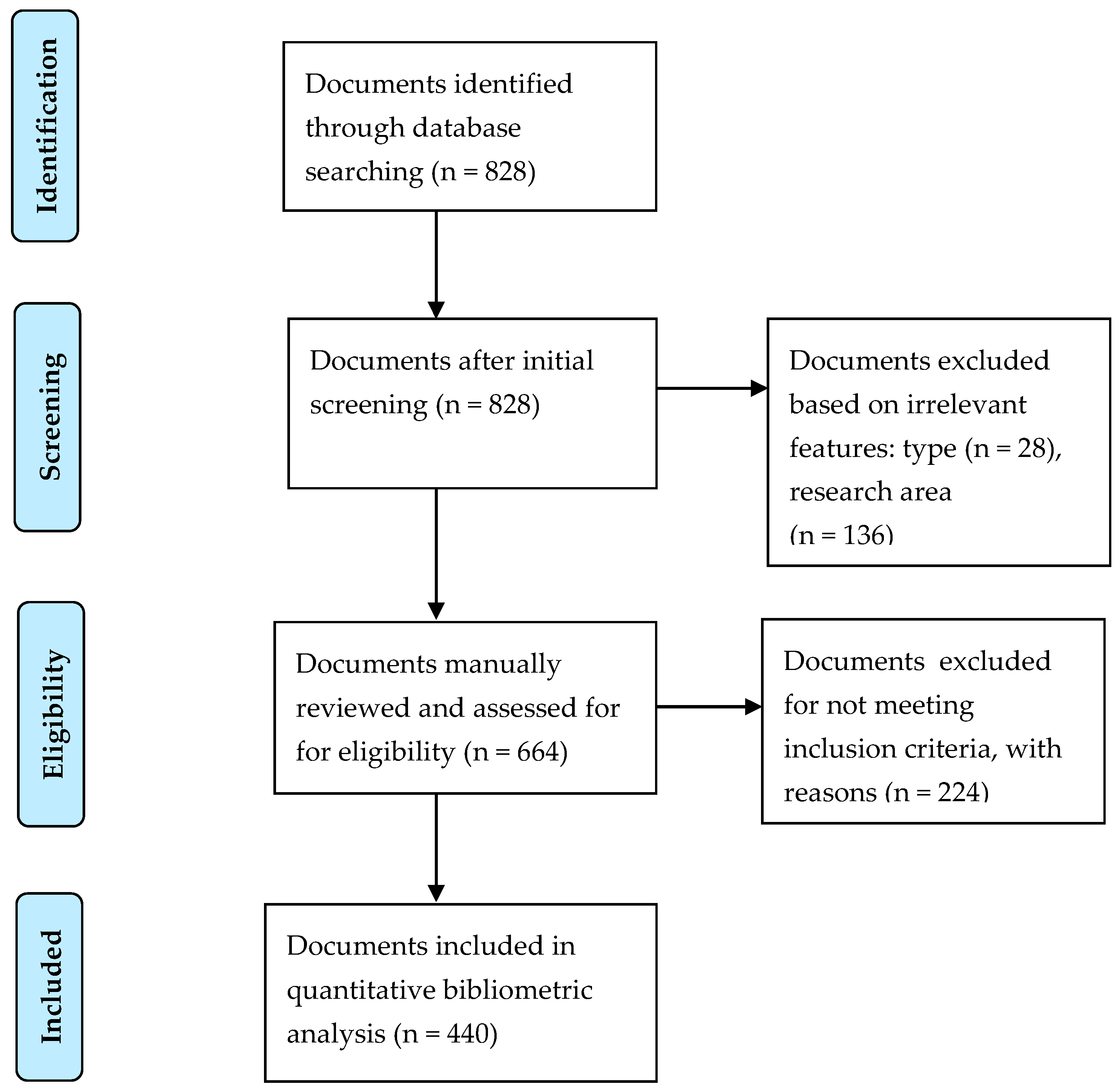
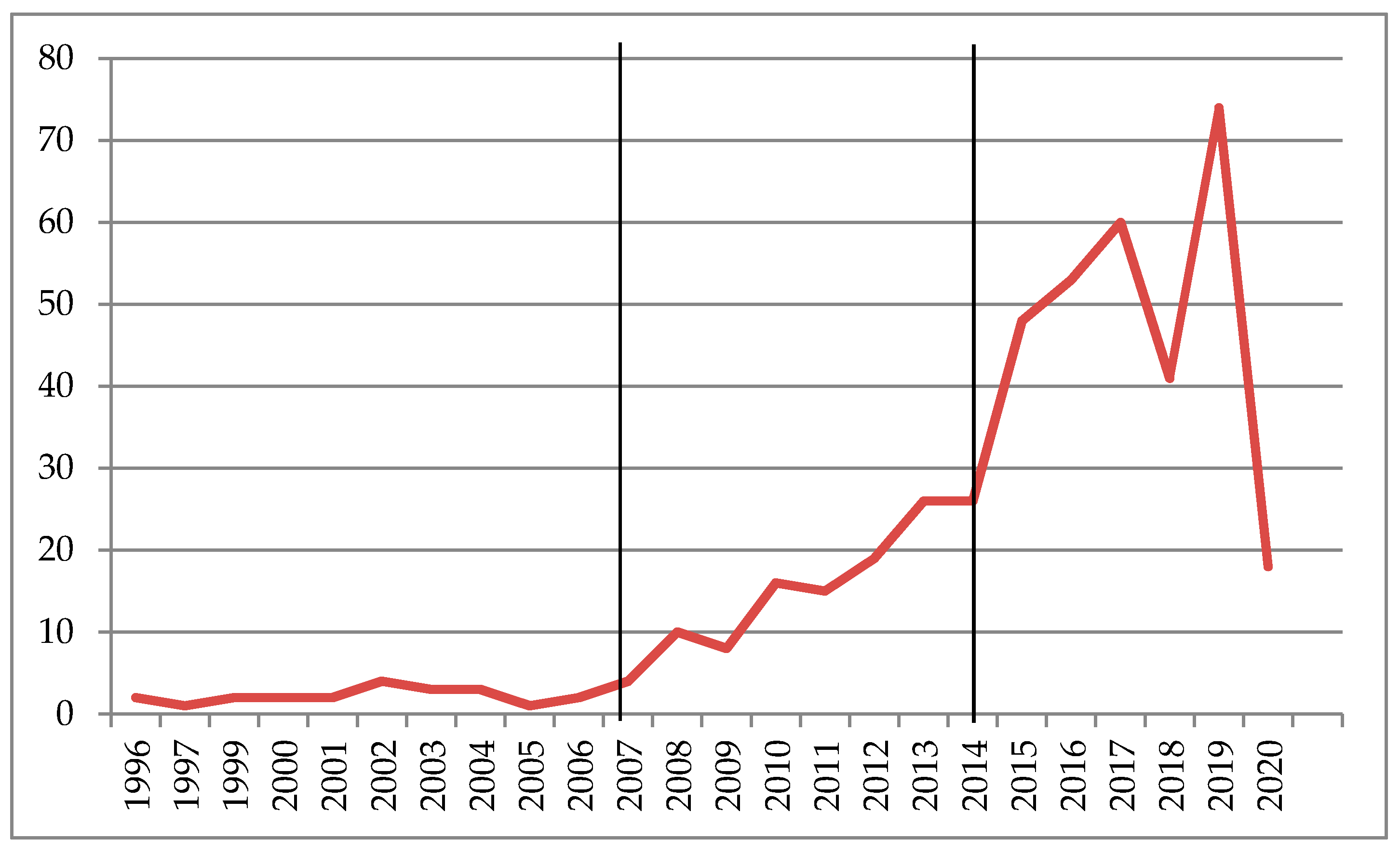

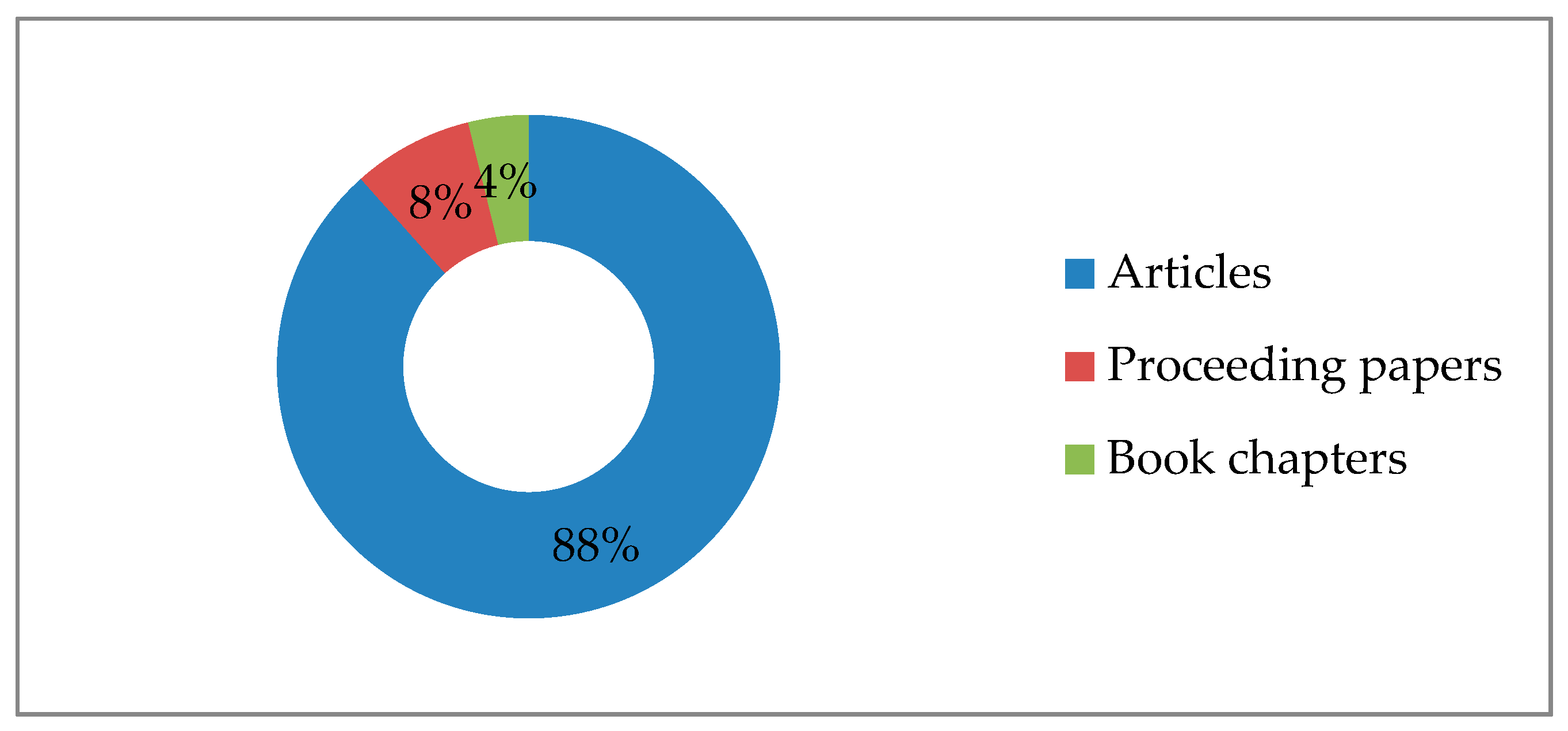
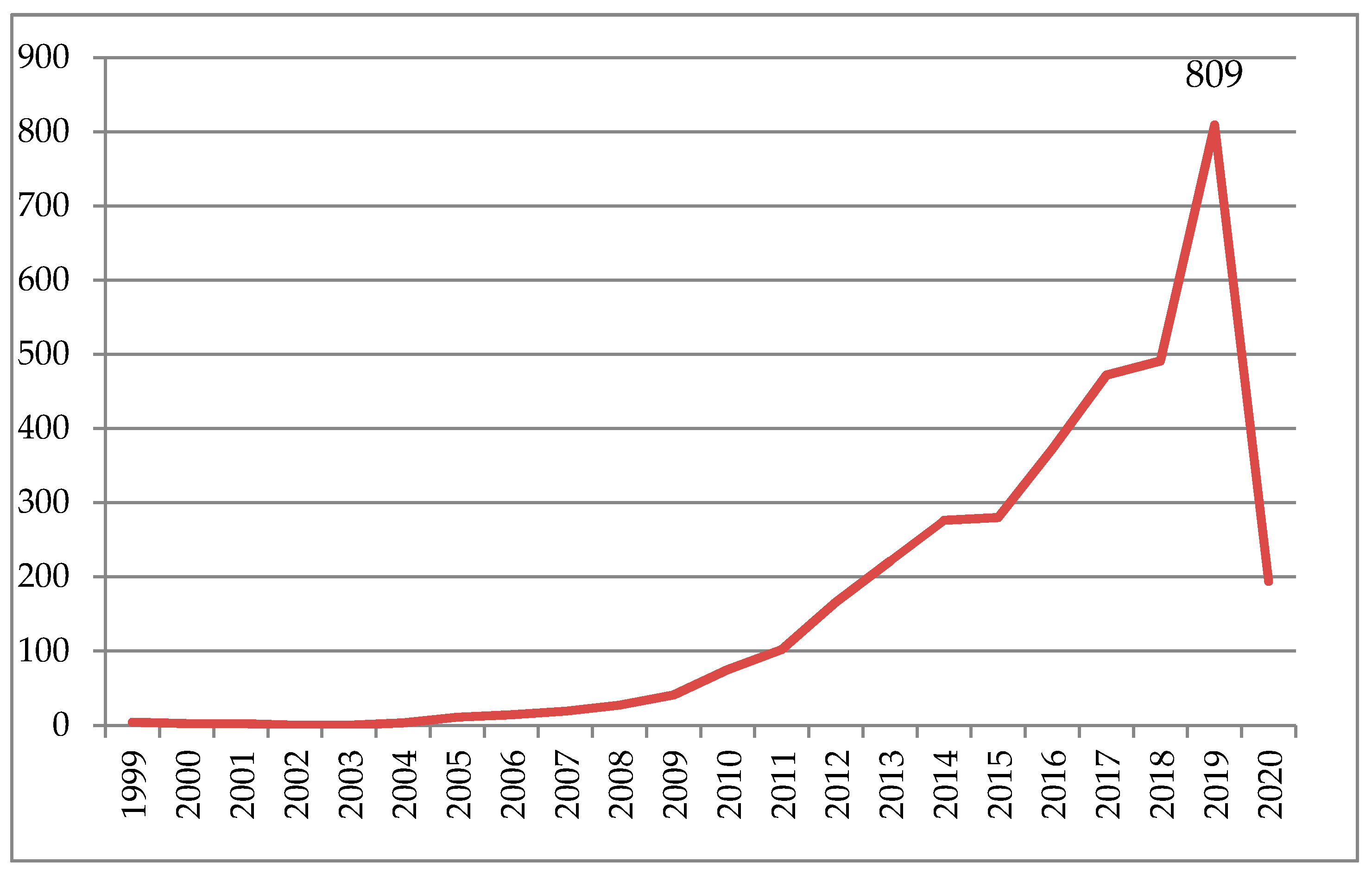

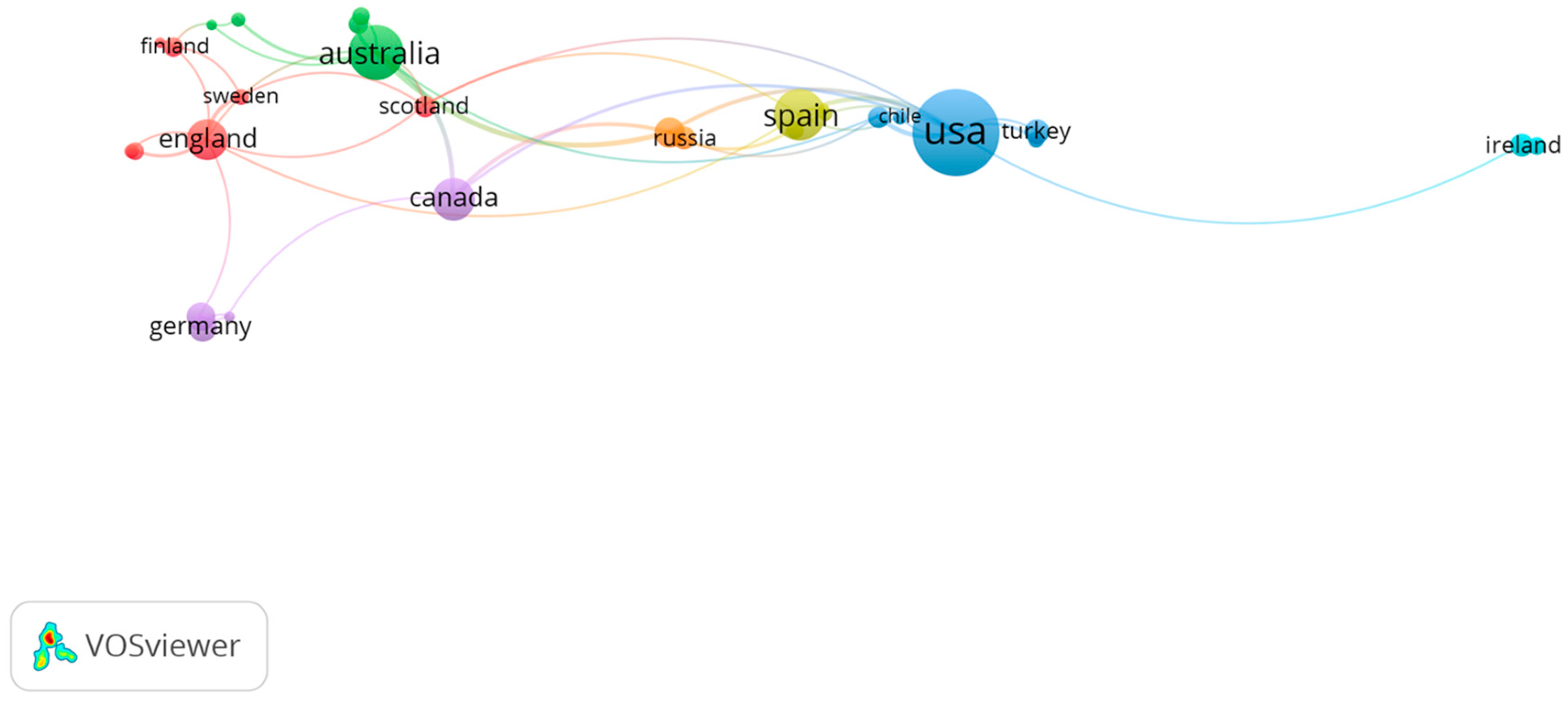
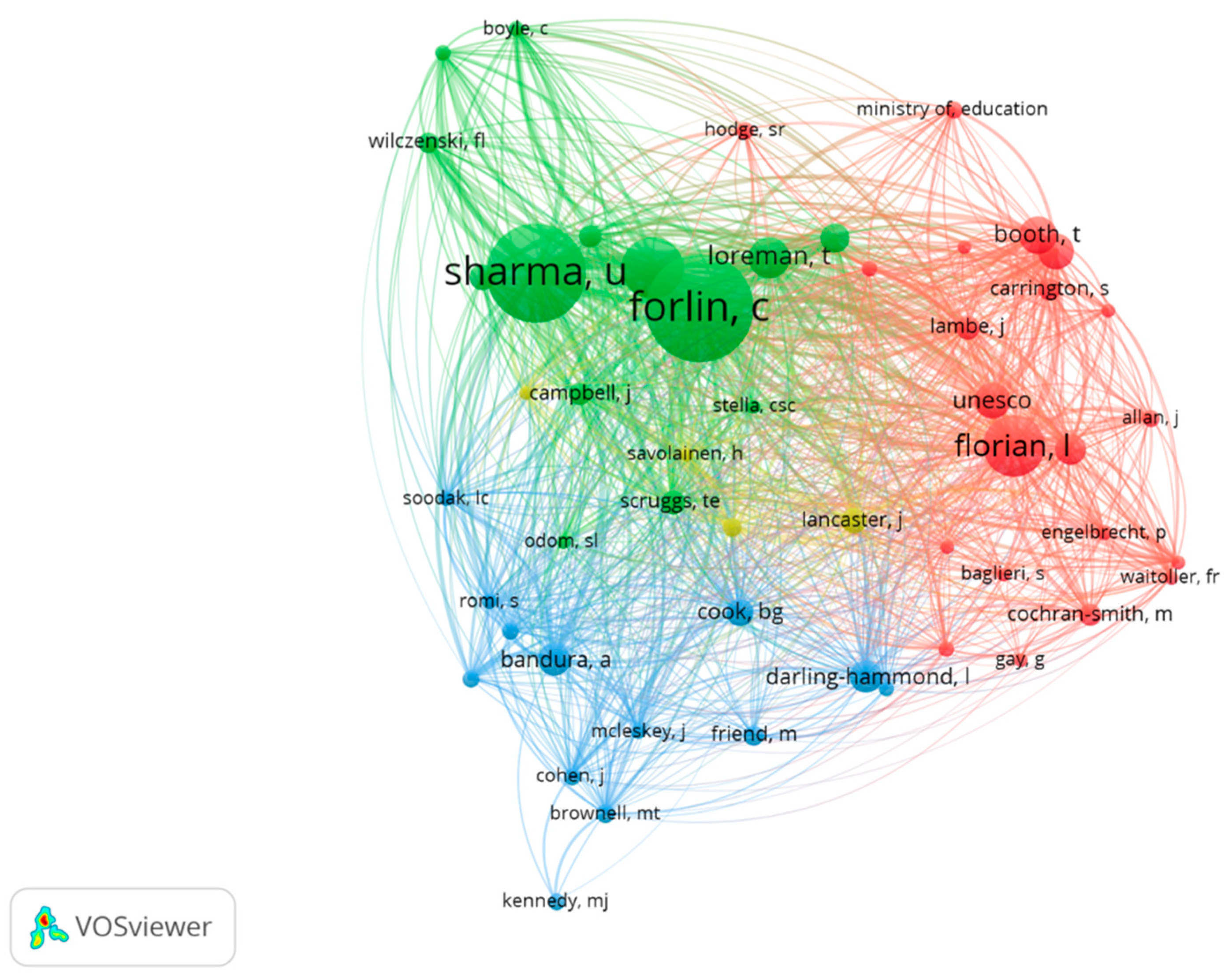

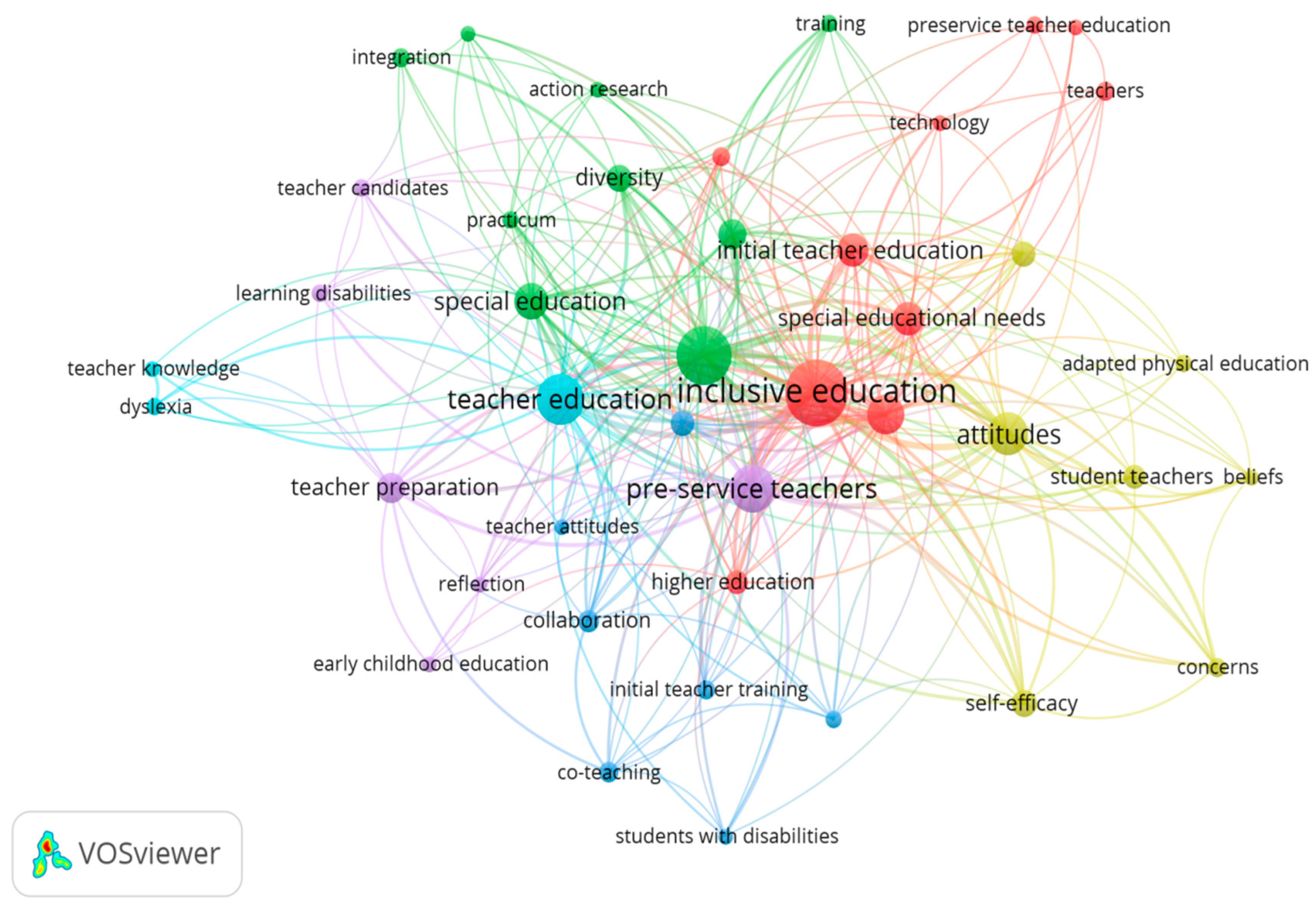
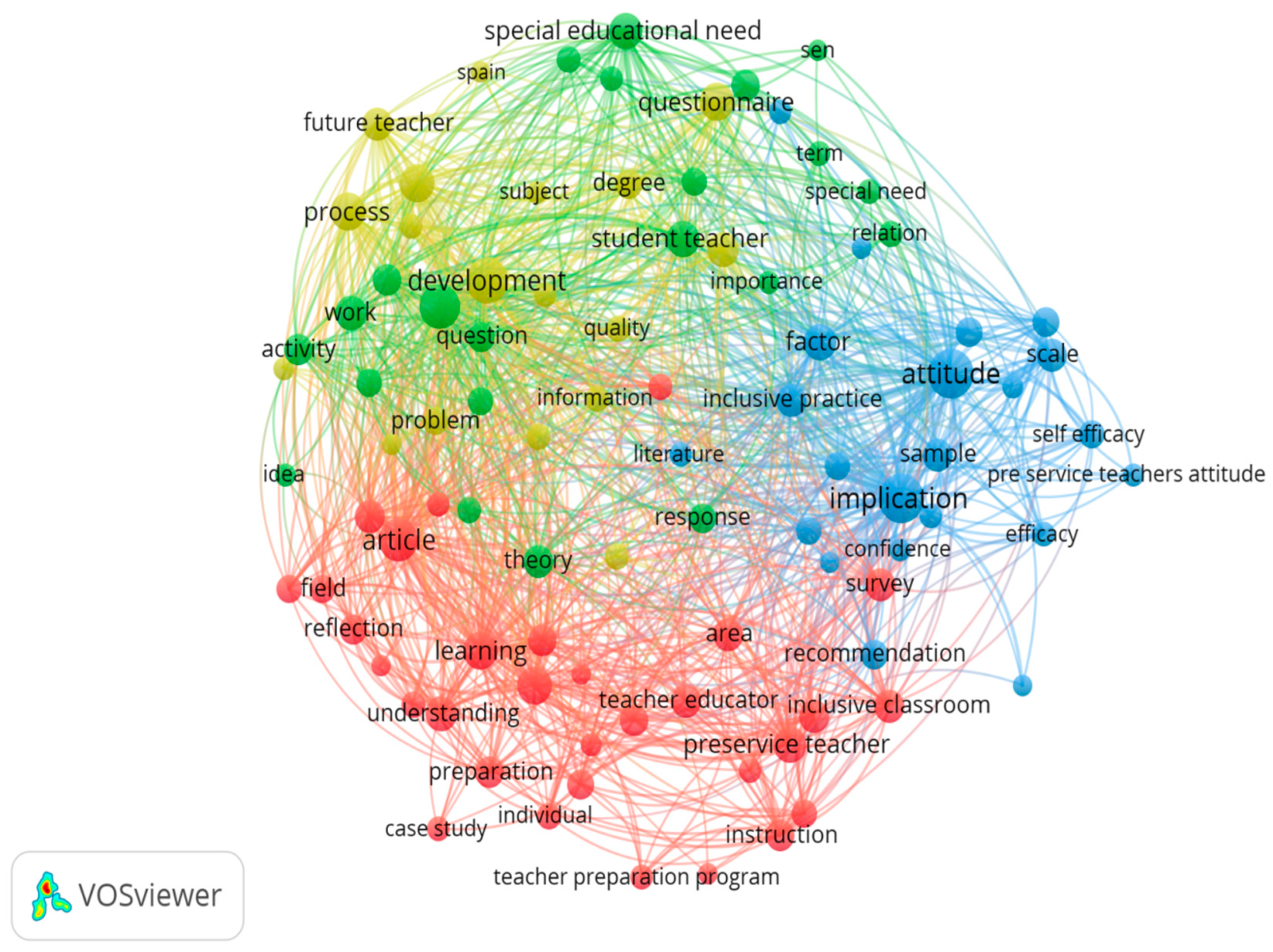
| Criteria | Details |
|---|---|
| Database | WoS Core Collection |
| Topic | ITEIE |
| Document type | Articles, book chapters, proceedings papers |
| Research area | Education and educational research |
| Document contents | Theoretical and empirical studies related to inclusive education in the initial teacher training at university level |
| Journals | Papers | % | IF (2018) | WoS Category |
|---|---|---|---|---|
| International Journal of Inclusive Education | 57 | 12.95% | 1.053 | EER |
| Teaching and Teacher Education | 24 | 5.45% | 2.411 | EER |
| Teacher Education and Special Education | 16 | 3.63% | 0.884 | EER |
| International Journal of Disability Development and Education | 12 | 2.72% | 0.818 | ES |
| Journal of Research in Special Educational Needs | 12 | 2.72% | - | SS, ES |
| European Journal of Special Needs Education | 10 | 2.27% | 1.039 | ES |
| Journal of Education for Teaching | 9 | 2.04% | 1.373 | EER |
| Asia Pacific Journal of Teacher Education | 8 | 1.81% | 0.903 | EER |
| Australian Journal of Teacher Education | 8 | 1.81% | - | SS, ES |
| European Physical Education Review | 8 | 1.81% | 2.0 | EER |
| Types of Documents | Number | Time Cited | h-Index | Average Citation/Item | Documents Cited | Documents Not Cited |
|---|---|---|---|---|---|---|
| Articles | 389 | 3538 | 27 | 9.1 | 266 | 123 |
| (98.79%) | (94.66%) | (77.35%) | ||||
| Proceedings papers | 34 | 21 | 3 | 0.62 | 7 | 27 |
| (0.58%) | (2.49%) | (16.98%) | ||||
| Book chapters | 17 | 22 | 3 | 1.29 | 8 | 9 |
| (0.61%) | (2.84%) | (5.66%) | ||||
| Total | 440 | 3581 | 281 | 159 |
| Authors | Region/Country | Documents | Citation | |
|---|---|---|---|---|
| 1 | Forlin, C. | Hong Kong/China | 9 | 551 |
| 2 | Sharma, U. | Australia | 12 | 443 |
| 3 | Loreman, T. | Canada | 4 | 336 |
| 4 | Florian, L. | Scotland | 5 | 320 |
| Title | Authors | Journal | Year | Citation | Citation per Year |
|---|---|---|---|---|---|
| Impact of training on pre-service teachers’ attitudes and concerns about inclusive education and sentiments about persons with disabilities | Sharma, U; Forlin, C; Loreman, T. | Disability & Society | 2008 | 172 | 13.31 |
| Changing student teachers’ attitudes towards disability and inclusion | Campbell, J.; Gilmore, L.; Cuskelly, M. | Journal of Intellectual & Developmental Disability | 2003 | 157 | 8.78 |
| Student teachers’ attitudes towards the inclusion of children with special educational needs in the ordinary school | Avramidis, E; Bayliss, P; Burden, R. | Teaching and Teacher Education | 2000 | 147 | 7.00 |
| Teacher preparation for inclusive education: Increasing knowledge but raising concerns | Forlin, C.; Chambers, D. | Asia-Pacific Journal of Teacher Education | 2011 | 125 | 12.50 |
| Demographic differences in changing pre-service teachers’ attitudes, sentiments, and concerns about inclusive education | Forlin, C.; Loreman, T.; Sharma, U.; et al. | International Journal of Inclusive Education | 2009 | 111 | 9.25 |
| Preparing teachers for inclusive education: Using inclusive pedagogy to enhance teaching and learning for all | Florian, L.; Linklater, H. | Cambridge Journal of Education | 2010 | 93 | 8.55 |
| The inclusive practice project in Scotland: Teacher education for inclusive education | Florian, L.; Rouse, M. | Teaching and Teacher Education | 2009 | 92 | 7.67 |
| Are preservice teachers prepared to teach struggling readers? | Washburn, E. K.; Joshi, R.M.; Cantrell, E.B. | Annals of Dyslexia | 2011 | 67 | 6.70 |
| Preparing Teachers to Work in Inclusive Classrooms: Key Lessons for the Professional Development of Teacher Educators from Scotland’s Inclusive Practice Project | Florian, L. | Journal of Teacher Education | 2012 | 66 | 7.33 |
| Efficacy beliefs, background variables, and differentiated instruction of Israeli prospective teachers | Wertheim, C.; Leyser, Y. | Journal of Educational Research | 2002 | 66 | 3.47 |
© 2020 by the authors. Licensee MDPI, Basel, Switzerland. This article is an open access article distributed under the terms and conditions of the Creative Commons Attribution (CC BY) license (http://creativecommons.org/licenses/by/4.0/).
Share and Cite
Cretu, D.M.; Morandau, F. Initial Teacher Education for Inclusive Education: A Bibliometric Analysis of Educational Research. Sustainability 2020, 12, 4923. https://doi.org/10.3390/su12124923
Cretu DM, Morandau F. Initial Teacher Education for Inclusive Education: A Bibliometric Analysis of Educational Research. Sustainability. 2020; 12(12):4923. https://doi.org/10.3390/su12124923
Chicago/Turabian StyleCretu, Daniela Maria, and Felicia Morandau. 2020. "Initial Teacher Education for Inclusive Education: A Bibliometric Analysis of Educational Research" Sustainability 12, no. 12: 4923. https://doi.org/10.3390/su12124923






